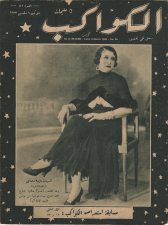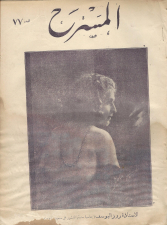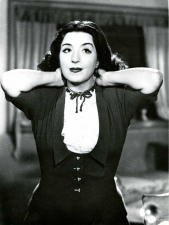The pioneers and the roaring twenties in Cairo
Divas, from Umm Kulthum to Dalida, invites us to discover the lives and careers of the greatest artists of Arab music and cinema from the 1920s to the 1970s.
Stars the likes of Umm Kulthum, Asmahan, Fairuz, Warda, Dalida, Tahiyya Carioca, Samia Gamal, Laila Murad, Sabah, Soad Hosny, Faten Hamama, and Hind Rostom are for the first time reunited and honored in an ambitious exhibition. Coming from modest families or part of the upper-class, orphans or exiled, Muslim, Christian or Jewish, their unique histories bear witness to the cultural and social diversity of the Arab world. The exhibition pays tribute to these powerful women that contributed to transforming the arts by excelling in them, and allowed Egypt and Lebanon to shine upon the Arab World. Breaking with traditions, they gave women an unprecedented place in the press, in the fields of music, dance, singing and cinema. Thanks to their talent, they led the oftentimes male-dominated crowd to extasy during concerts to hold their breath in movie theaters. Beyond their artistic genius, they incarnated the ideals of Arab society and some fervently defended their political positions. They knew how to take advantage of the century’s technological evolutions, the coming of age of the record, the radio and of cinema. Going beyond borders, they conquered the heart of the Arab public, from Damas to Casablanca, from Paris to Algiers.
Their fight for emancipation still resonates in today’s creations. The exhibition ends with installations, most of them never exhibited before, by seven international artists that bear witness to the durability of the divas’ legacies in contemporary art and music.
Thanks to the families of these divas, to their friends but also to passionate collectors, unique works were reunited here for the first time. Mirroring the intimate and public portraits of these exceptional artists, this is a political, intellectual and social story of the Arab world that takes shape, interrogating the place of women in Arab societies.
The pioneers and the roaring twenties in Cairo
In the beginning of the 20th century, Egypt went through important political, societal, artistic and technological transformations. The Nahda (intellectual renaissance) was then at its peak and Cairo was a cosmopolitan city at the center of the Arab world’s artistic activity. Born within the bourgeoisie, a movement opposed to British colonialism wishing to break with the past, advocated for nationalist ideas and dreamed of modernity. Women actively supported these uprisings and got engaged in other fights to advance their freedoms.
Others held a defining role in the artistic revolution that was unfolding. As the first women to go onstage, they contributed to the emergence of concert halls and cabarets in the capital. They actively participated to the changes that took place in music and were at the heart of the emergence of an Egyptian cinema. True pioneers, they paved the way for the great Arab divas as artists but also as entrepreneurs and businesswomen. Here, we pay tribute to their talent and visionary deeds that have gradually fallen into oblivion.
The feminist cause in Egypt
In the 1920s in Cairo, personalities like Hoda Chaaraoui, Ceza Nabaraoui or Safia Zaghoul, fought for women’s emancipation and were engaged in anti-imperialist movements. They took a stand as soon as 1919 by protesting in the streets against the English presence. These upper-class born feminists focused their actions on issues such as the veil, education, women’s right to vote and marriage and divorce legislation. Some, such as the famous writer May Ziadeh, held a “salon” where intellectuals and politicians came to discuss. By letting men into the private sphere, they upset traditional codes. They were journalists, writers and founders of newspapers, and used Arabic and French, more rarely English, to spread their ideas. The 1920s were the years of the first public unveilings that would come to shake up the place of women’s bodies in the city.
When women go on stage
At the end of the 19th century in Egypt, musicians would perform for particular occasions in closed upper-class circles. These so-called classical representations of music used classical Arabic and were based on improvisation. In 1906, a true revolution came about with the advent of the 78-rpm record. The structure of songs got shorter in order to adapt to this new support. In parallel, concert halls called “casinos” multiplied in the streets of Cairo and music then became accessible to all. A real industry, carried by production companies, started to offer more entertaining genres. Women, the new actors of the musical scene, gained the status of moutribat (singers) and played an important role by interpreting a light genre of music called taqtûqa. All these factors contributed to bringing singers to the forefront where they gained public recognition.
Mounira al-Mahdiyya (1885-1965)
 The Abûshady Archive
The Abûshady Archive
Better known under the name of Sett Munira (Madam Munira), the singer recorded her first vinyl as early as 1906. Early in this century, she gave numerous representations of classical music in the singing cafés of Cairo and the cabarets of the Azbakiyya garden. As early as 1914, she initiated the transition towards so-called variety songs that made the music more accessible to the wider public. In 1916, she began a career in theatre. She became the first Muslim woman to go on stage, dressed as a man in the play Saladin. In the 1920s, then at the peak of her glory and referred to as Sultânat al-Tarab (the Sultana of singing), she was recognized in Egypt and across the Levant as the most famous singer of her time.
Badia Massabni (1892-1975)
 Abboudi Bou Jawde
Abboudi Bou Jawde
Of Syrian-Lebanese origins, Badia Massabni settled in Egypt where she began an artistic career. A true pioneer in the field of dance and spectacle, she opened the first cabarets in Alexandria then in Cairo. In 1929, she created the very famous Sala Badia and formed a troupe of dancers alongside it whose members went on to become the greatest musical comedies stars from the 1940s onwards. She modernized traditional dances and defined the sharqî style’s codes that will become popular in movies: garments made with rhinestones, pearls and sequins, movements made of arabesques and ripples. In 1936, she produced her film The Music-hall Queen that inaugurates the «golden age» of dance in Egyptian cinema.
Rose Al-Youssef (1879-1947)
 Abboudi Bou Jawde
Abboudi Bou Jawde
Born in Lebanon, Fatma of her real name is an emblematic figure of the Egyptian press and theatre in the interwar period. She arrived in Alexandria at the age of 12 and discovered theatre in Cairo a few years later, first as a costume designer then as an actress. She soon became the greatest star of Egyptian theatre as part of Yussef Wahbi’s notorious Ramses company. She then quit the company over a disagreement with him and created her own intellectual salon in Cairo in the 1920s. In 1924, she founded the famous cultural and political magazine Rose al-Youssef, the only one in the world to be named after a woman. Famous for its press caricatures, it became very popular and influential. This weekly magazine is still running today despite the death of its founder in 1958.
From the stage to the big screen: the pioneers of cinema
In the beginning of the 20th century, Egyptian musicals were a very masculine environment. Women were underrepresented and the actors and actresses are often of Syrian-Lebanese origins, whether Christian or Jewish. Munira al-Mahdiyya was the first Muslim woman to appear on a theatre stage in 1916. In just a few years, numerous female artists successfully defied the male-dominated world of entertainment. As they reached stardom, their pictures invaded the press and the shows’ posters put them in the spotlight. They appeared modern and unveiled. The first entirely Egyptian feature, Laila in 1927 (by and with Aziza Amir), already showed ties with theatre; many great pioneers of cinema have started their careers on stage. In its beginnings, Egyptian cinema was carried by private companies where each star owned their own company. The “actresses-producers”, Aziza Amir (Isis film), Assia Dagher (Lotus film), and Bahiga Hafez (Fanar film) were then notorious personalities in these circles. With the advent of talking cinema in 1932, films were structured around singing, similarly to theatre.
Aziza Amir (1901-1952)
 IMA
IMA
Aziza Amir evolved in a highly cultured milieu and opened in the 1920s in Cairo a salon where personalities of the art and literary worlds would gather. In 1925, she started a career in theatre and joined Yussef Wahbi’s Ramses company. She played several roles until 1935, year of her final appearance on stage. Aziza Amir played a central role in the emergence of cinema in Egypt as a producer, an actress and a filmmaker. In 1929, she created the first Egyptian feature film, Laila, where she played the lead role. She took part in writing the screenplay and directed filmmakers Wedad Orfi and Oustiphane Rusty. The success of Laila led her to found her own production company, Isis films.
Assia Dagher (1908-1986)
 Abboudi Bou Jawde
Abboudi Bou Jawde
Born in a Christian family in Lebanon, Assia arrived in Egypt in 1923. Early on, she developed a passion for cinema. Her debut was as a wide-eyed 19-year-old girl with pale skin and proud posture, an extra in the legendary Laila. An ambitious woman, she became a producer by founding Lotus film in 1929. A first feature film, Desert Beauty, was released that same year, produced by and starring Assia. She played in more than twenty films and it’s basked in glory but aware of the limits of her acting that she put her career on pause. As a producer, she gave chances to her niece Mary Queeny and her husband Ahmad Galal who would later found the famous Galal Studio. Her successes would earn her the Egyptian nationality. Her genius and her sensitivity made her the country’s most ambitious producer in the 1960s.
Bahiga Hafez (1908-1983)
 IMA
IMA
Born in an Egyptian aristocratic family, Bahiga Hafez is one of Egyptian cinema’s major figures. In 1930, she played the lead role and composed the music of the film Zeinab by Mohammed Karim. Her strong personality, skills in music and editing as well as her knowledge of dubbing led her to create her own production company Fanar films in 1932. She showed an absolute virtuosity when, in 1937, she handled all the steps in the making of the film Laila, the desert girl which was later selected to participate in the Venice festival in 1938: screenplay, musical score, costumes, lead role. At the end of her career, music connoisseurs would gather in her house which became a place of high culture.
Inscription à la newsletter
Pour recevoir toute l'actualité de l'Institut du monde arabe sur les sujets qui vous intéressent
Je m'inscris


















